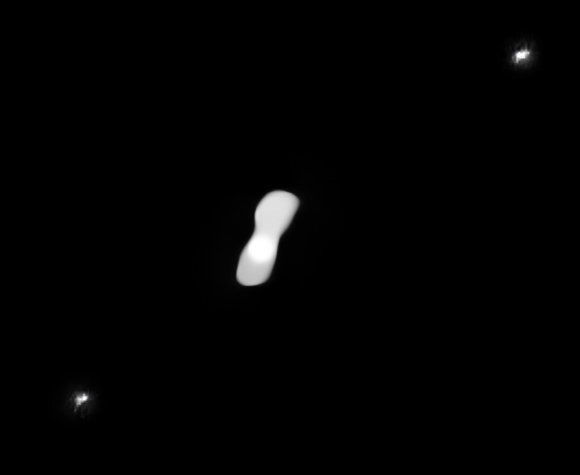Astronomers using ESO’s Very Large Telescope (VLT) have determined the 3D shape and the mass of the asteroid (216) Kleopatra and correct orbits of its two moons.

This processed image, based on observations taken in July 2017, shows the two moons of the asteroid Kleopatra and its two moons, AlexHelios and CleoSelene. The moons are difficult to see in the raw images — which were taken with the SPHERE instrument on VLT — owing to glare around the asteroid, inherent to this kind of adaptive-optics observations. Image credit: ESO / Vernazza / Marchis et al. / MISTRAL algorithm / ONERA / CNRS.
(216) Kleopatra is a non-family M-type asteroid from the background population of the main asteroid belt.
The asteroid was discovered on April 10, 1880 by Johann Palisa, a famous Czech astronomer working at the Austrian Naval Pola Observatory located in Croatia.
Its two small moons, named AlexHelios and CleoSelene, were discovered in 2008.
Astronomers call Kleopatra a ‘dog-bone asteroid’ because radar observations around 20 years ago revealed it has two lobes connected by a thick ‘neck.’
“Kleopatra is truly a unique body in our Solar System,” said Dr. Franck Marchis, an astronomer at the SETI Institute and the Laboratoire d’Astrophysique de Marseille.
“Science makes a lot of progress thanks to the study of weird outliers. I think Kleopatra is one of those and understanding this complex, multiple asteroid system can help us learn more about our Solar System.”
To find out more about Kleopatra, Dr. Marchis and colleagues used snapshots of the asteroid taken at different times between 2017 and 2019 with the SPHERE instrument on VLT.
As the asteroid was rotating, they were able to view it from different angles and to create the most accurate 3D models of its shape to date.
They constrained the asteroid’s dog-bone shape and its volume, finding one of the lobes to be larger than the other.
They also determined the length of the asteroid to be about 270 km (168 miles).
In a separate study, the astronomers used the SPHERE observations to find the correct orbits of Kleopatra’s two moons.
They managed to precisely describe how Kleopatra’s gravity influences the moons’ movements and to determine their complex orbits.
This allowed them to calculate the asteroid’s mass, finding it to be 35% lower than previous estimates.
Combining the new estimates for volume and mass, the team was able to calculate a new value for the density of the asteroid, which, at less than half the density of iron, turned out to be lower than previously thought.
The low density of Kleopatra, which is believed to have a metallic composition, suggests that it has a porous structure and could be little more than a ‘pile of rubble.’
This means it likely formed when material reaccumulated following a giant impact.
Kleopatra’s rubble-pile structure and the way it rotates also give indications as to how its two moons could have formed.
The asteroid rotates almost at a critical speed, the speed above which it would start to fall apart, and even small impacts may lift pebbles off its surface.
“Kleopatra is a puzzling multiple system due to the unique characteristics of the primary,” the authors said.
“This system certainly deserves particular attention in the future, with the Extremely Large Telescopes and possibly a dedicated space mission, to decipher its entire formation history.”
The findings appear in two papers in the journal Astronomy & Astrophysics.
_____
F. Marchis et al. 2021. (216) Kleopatra, a low density critically rotating M-type asteroid. A&A 653, A57; doi: 10.1051/0004-6361/202140874
M. Brož et al. 2021. An advanced multipole model for (216) Kleopatra triple system. A&A 653, A56; doi: 10.1051/0004-6361/202140901







